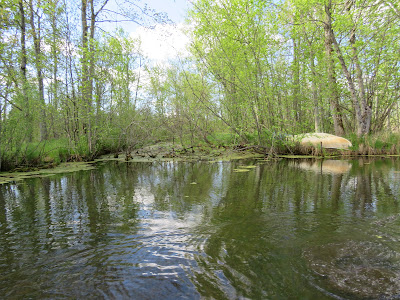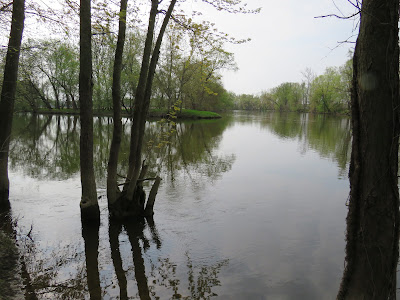Continuing my quest to follow the Maple River from its mouth to its source, I’m on a morning hike in a section of the State Game Area just west of Clinton County’s village of Maple Rapids. With temperatures in the low 50’s, under party sunny skies, I stand on the muddy shore of the Maple River listening to a chorus of birdsongs as the water flows slowly past. Moving along the riverbank, I spot white blossoms of Foxglove Beardtongue as well as a few, 1-inch Fragile Forktail damselflies perching on blades of grass. This species, especially the females, are among those that eat other damselflies, including their own species. They will grab small flying or perched insects and have even been known to rob spider webs. Following a gravel road parallel to the river, I gaze skyward to see a perching Great Crested Flycatcher and look down to see the fresh carcass of a an 18-inch, juvenile River Otter. Up ahead, I come upon an oak sapling with leaves riddled with holes. Upon closer look, I notice tiny, ½ inch Spongy Moth (formerly Gypsy Moth) caterpillars feeding on the leaves. Called instars, these larvae go through several molts before reaching full size. Large numbers of adult caterpillars have been known to defoliate an entire stand of trees, especially oak. Back to the river’s edge, I spot an aggregation of ¼-inch Whirligig Beetles (stock photo)skating on the water while listening to the mimicking vocals of a Catbird. Next, my attention is drawn to both the lovely aroma and blossoms of Pink Honeysuckle. Turning my gaze back to the river, I notice the glittering water surface, a chorus of birds including, American Redstart and Baltimore Oriole followed by a muskrat swimming for shore. Turning around, I come upon a fisherman who shows me a recently caught, 20-inch Channel Catfish. What makes these fish so remarkable is their acute senses. Every available space on their bodies is allotted for taste-sensing. Even their whisker-like barbels are covered in taste buds. Beside taste, their sense of smell, hearing and seeing are second to none. They can smell compounds as weak as one part per billion. Their whole-body acts like an ear drum allowing them to detect the faintest noises. Even extremely low frequency sound can be detected using tiny hair-like projections inside the fish’s pores. Catfish eyesight is so good that they can spot other fish from quite a distance in clear water. In addition, these fish, much like sharks, can detect electrical fields in a sense known as electroreception. They use this when searching for their prey in mud. Approaching the car, I get a quick glimpse of a female, Baltimore Oriole looking for food.
Mid-morning of the day
Riverbank shows the way
Weeping willows sway
Skyward, noisy Jay
Perching, Catbird gray
Souring hawk eyes its prey
Frisky fawn wants to play
Green leaves, here to stay
Nature’s springtime display
Fond farewell to May
D. DeGraaf




